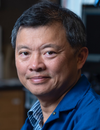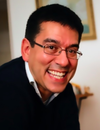08:00 | Registration |
|
Advances in Microfluidics |
| |
09:00 |  | Keynote Presentation Microfluidic Biological Processors for Cells, Vesicles and Tissue
Abraham Lee, Professor, University of California Irvine, United States of America
Cells host the most basic molecular functions of life and also form the basic unit of living creatures. This talk will highlight technical advances in processing cells and cell-like vesicles on microfluidic platforms. |
|
10:00 | Coffee Break and Networking in the Exhibition Hall |
10:45 | Advancements in Automated Sample Preparation, STR-PCR, and CE Detection for Rapid Nucleic Acid Analysis on an Integrated Microfluidic Platform
Frederic Zenhausern, Director and Professor, Center for Applied Nanobioscience and Medicine, United States of America
The authors demonstrate automated workflow processing of solid-phase biological samples on a real world size scale; quickly extracting genetic biomaterials, performing 17-plex STR-PCR amplification, and delivering the amplicons to downstream multiplexed CE detection. |
11:30 | Smart Polymer-based Microfluidics
Eui-Hyeok Yang, Professor, Stevens Institute of Technology, United States of America
We are investigating tunable wetting of a smart polymer - dodecylbenzenesulfonate-doped polypyrrole (PPy(DBS)). Here, we are probing fundamental mechanisms related to the electrochemical transport and reversible wetting states of PPy(DBS) upon continuous reduction and oxidation reactions. Successful research on this tunable wetting concept will impact a wide range of microfluidics applications, attributed to the low-voltage operation. |
12:15 |  Technology Spotlight: Technology Spotlight:
More Accuracy & Precision, Through Tighter Tolerances & Smoother Microfluidic Channels - A Case Study
Harald Denz, MD & CEO, , Austria
Nick Lewis, Sales & Marketing North America, z-microsystems®, United States of America
z-microsystems is a 60 years tooling and injection molding company. Since 13 years we are a reliable partner for our customers in the medical market. In this technology spotlight we give you insights into thin channels, chambers and variation of different thicknesses are possible to manufacture in several forms of e.g. chips, cartridges, micro arrays with optical combination and so on. The one of the main Advantages is the roughness smooth and precise Nano- or Microstructures with small tolerances to build up in the insert and in the injection molded parts too. We are ISO 9001:2008 ISO 13485:2003 + AC:2007 certified. Processes: Fluidic development, Prototyping, Pre Series, Series, Bonding, Coating.
|
12:30 | Lunch and Networking in Exhibition Hall |
13:30 | Poster Viewing Session |
14:15 | Mapping Chemical Gradients in Living Tissue in Space and Time Using Microfluidics
Charles Henry, Professor and Chair, Colorado State University, United States of America
Chemical gradients drive biological functions ranging from nerve signaling to ovulation. Yet our knowledge of the complex gradients that lead to cell-to-cell communication across intact organs is limited by the lack of tools outside of microscopy available of measuring these gradients. This presentation will focus on microfluidic-based methods for measuring spatiotemporal chemical gradients in living tissues. |
15:00 | Shrink Manufacturing Advanced Research Tools (SMART)
Michelle Khine, Associate Professor, University Of California Irvine, United States of America
Leveraging the inherent heat-induced relaxation of pre-stressed thermoplastic sheets - commodity shrink-wrap film - we pattern in a variety of ways at the large scale and achieve our desired structures by controlled shrinking down to 5% of the original, patterned sizes. This enables us to 'beat' the limit of resolution inherent to traditional 'top-down' manufacturing approaches. With these tunable shape memory polymers, we can robustly integrate extremely high surface area and high aspect ratio nanostructures directly into our microsystems. |
15:45 | Coffee Break and Networking in the Exhibition Hall |
|
Nanotechnological Applications |
| |
16:30 | Enhancing the Performance of Distributed Feedback Dye Lasers and Plasmonic V-grooves for Lab-on-a-chip Systems
Cameron Smith, Researcher, Technical University of Denmark, United Kingdom
Polymer-based distributed feedback dye lasers are inexpensive devices that may be tailored to exhibit highly sensitive transduction. Plasmonic V-grooves offer unique opportunities
for unobtrusive particle and single molecule manipulation. We consider both of
these approaches with respect to lab-on-a-chip systems. |
17:15 | Reception and Roundtable Discussions in Exhibition Hall |
19:30 | End of Day One |



